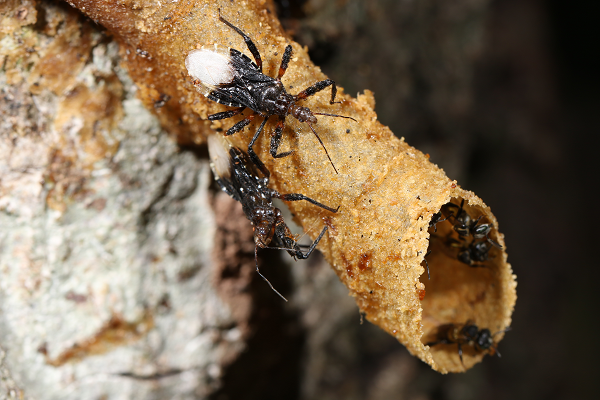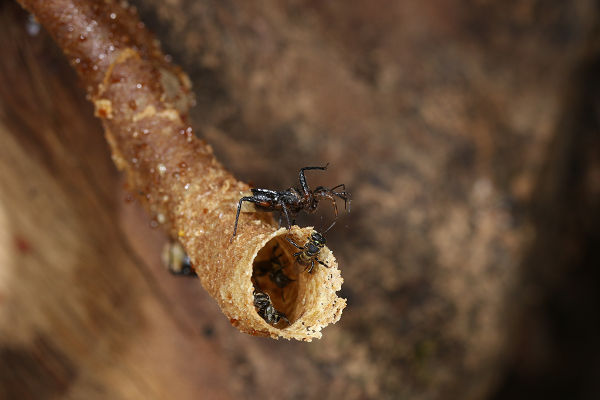
Tool use is widely reported across a broad range of the animal kingdom, mainly among vertebrates. Now, however, Chinese researchers have identified a remarkable example of tool use in the insect world.
The researchers, from China Agricultural University, Xishuangbanna Tropical Botanical Garden (XTBG) of the Chinese Academy of Sciences (CAS), and the Institute of Zoology of CAS, have described how the assassin bug, Pahabengkakia piliceps (P. piliceps), weaponizes resin from stingless bee nests to lure the bees into the predator’s optimal hunting position. This is the first comprehensive evidence of an invertebrate predator using tools to exploit the collective defenses of social insects.
The study was published in PNAS on May 12.
Stingless bees deposit sticky, pungent resin around their nest entrances to deter intruders. When predators like ants or geckos become stuck, guard bees swarm to immobilize them. But the assassin bug turns this defensive mechanism against the bees.
The researchers observed that the assassin bug deliberately collects resin with its fore- and mid-legs to coat them with the sticky material. The resin’s amplified chemical signal then lures the guard bees to the assassin bug’s location. In this way, the resin not only fails to repel the predator but instead acts as a beacon, drawing bees into striking range.
“This is a sophisticated manipulation of prey behavior,” said WANG Zhengwei from XTBG. “The bug doesn't just avoid detection—it actively provokes attacks to create opportunities.”
Through controlled field trials, the researchers demonstrated that resin-coated assassin bugs achieved a predation success rate of 75%. This rate dropped to less than 30% for bugs without resin. Crucially, they found that applying resin to non-hunting body parts (e.g., abdomen) also offered relative benefit, confirming that the resin’s stickiness was not the key to predatory success. Instead, chemical analyses revealed that the bugs’ resin handling boosted emissions of volatile compounds, which were irresistible to guard bees.
As a specialist predator, P. piliceps relies entirely on stingless bees for survival and reproduction. This dependency likely drove the evolution of its unique tool-use behavior. The use of tools (defensive resin of bees) by predatory bugs to improve their hunting efficiency indicates a link between tool-use behavior and dietary specialization in the animal kingdom.
The study challenges assumptions that complex tool use requires advanced cognition, highlighting how ecological specialization can shape seemingly intelligent behaviors. “Unlike vertebrates, insects like P. piliceps offer a practical system to explore evolution of tool use behavior in animal,” said WANG.

The bug climbing onto the stingless bee nest tube. (Image by CHEN Zhaoyang)

The bug raises its fore legs at the entrance preparing to prey. (Image by CHEN Zhaoyang)

86-10-68597521 (day)
86-10-68597289 (night)

52 Sanlihe Rd., Xicheng District,
Beijing, China (100864)

